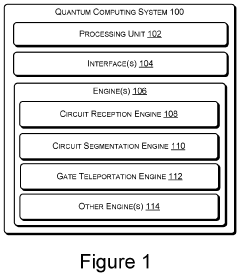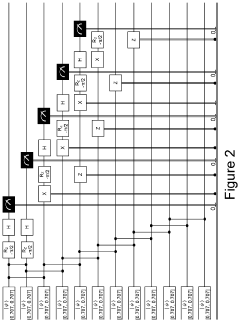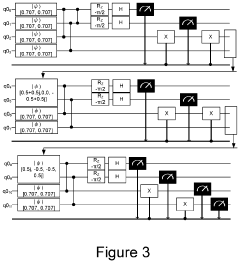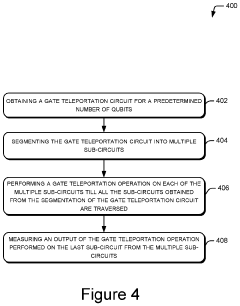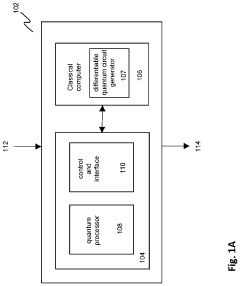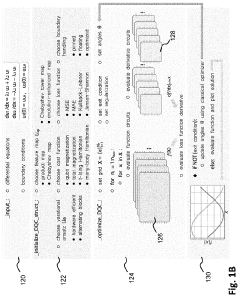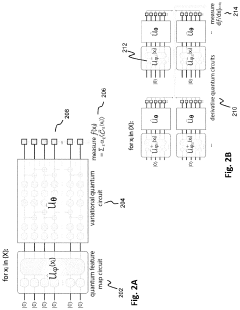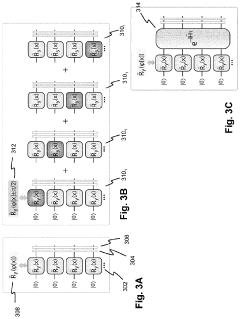Quantum Computing's Impact on Spectroscopy Techniques
JUL 17, 20259 MIN READ
Generate Your Research Report Instantly with AI Agent
Patsnap Eureka helps you evaluate technical feasibility & market potential.
Quantum Spectroscopy Evolution and Objectives
Quantum spectroscopy has emerged as a revolutionary field at the intersection of quantum computing and spectroscopic techniques. The evolution of this domain has been driven by the need for more precise and efficient methods of analyzing matter at the atomic and molecular levels. Traditional spectroscopy has long been a cornerstone of scientific research, but quantum computing promises to unlock unprecedented capabilities in this field.
The primary objective of quantum spectroscopy is to harness the power of quantum systems to enhance spectroscopic measurements and data analysis. This involves leveraging quantum phenomena such as superposition and entanglement to achieve higher sensitivity, resolution, and speed in spectroscopic techniques. By doing so, researchers aim to overcome the limitations of classical spectroscopy and explore new frontiers in material science, chemistry, and physics.
One of the key goals in the evolution of quantum spectroscopy is the development of quantum sensors that can detect and measure quantum states with extraordinary precision. These sensors have the potential to revolutionize fields such as magnetic resonance spectroscopy, enabling the detection of single-spin magnetic resonance and pushing the boundaries of molecular imaging.
Another significant objective is the creation of quantum-enhanced spectroscopic techniques that can probe complex molecular systems with unprecedented accuracy. This includes the ability to study quantum dynamics in real-time, offering insights into chemical reactions and biological processes at the quantum level. Such advancements could lead to breakthroughs in drug discovery, materials engineering, and our understanding of fundamental quantum processes in nature.
The integration of quantum computing algorithms with spectroscopic data analysis is also a crucial aspect of the field's evolution. Quantum algorithms have the potential to process vast amounts of spectral data more efficiently than classical computers, enabling faster and more accurate interpretation of results. This could dramatically accelerate research in areas such as atmospheric science, where complex spectral data from remote sensing instruments require intensive computational analysis.
As quantum spectroscopy continues to evolve, researchers are also focusing on developing practical applications that can transition from laboratory experiments to real-world implementations. This includes the creation of portable quantum spectroscopic devices that could be used for on-site chemical analysis, environmental monitoring, and medical diagnostics.
The long-term vision for quantum spectroscopy encompasses the ability to perform non-invasive, high-resolution spectroscopy on individual atoms and molecules, potentially revolutionizing our ability to study and manipulate matter at the most fundamental levels. This could lead to transformative applications in quantum chemistry, materials science, and even quantum communication technologies.
The primary objective of quantum spectroscopy is to harness the power of quantum systems to enhance spectroscopic measurements and data analysis. This involves leveraging quantum phenomena such as superposition and entanglement to achieve higher sensitivity, resolution, and speed in spectroscopic techniques. By doing so, researchers aim to overcome the limitations of classical spectroscopy and explore new frontiers in material science, chemistry, and physics.
One of the key goals in the evolution of quantum spectroscopy is the development of quantum sensors that can detect and measure quantum states with extraordinary precision. These sensors have the potential to revolutionize fields such as magnetic resonance spectroscopy, enabling the detection of single-spin magnetic resonance and pushing the boundaries of molecular imaging.
Another significant objective is the creation of quantum-enhanced spectroscopic techniques that can probe complex molecular systems with unprecedented accuracy. This includes the ability to study quantum dynamics in real-time, offering insights into chemical reactions and biological processes at the quantum level. Such advancements could lead to breakthroughs in drug discovery, materials engineering, and our understanding of fundamental quantum processes in nature.
The integration of quantum computing algorithms with spectroscopic data analysis is also a crucial aspect of the field's evolution. Quantum algorithms have the potential to process vast amounts of spectral data more efficiently than classical computers, enabling faster and more accurate interpretation of results. This could dramatically accelerate research in areas such as atmospheric science, where complex spectral data from remote sensing instruments require intensive computational analysis.
As quantum spectroscopy continues to evolve, researchers are also focusing on developing practical applications that can transition from laboratory experiments to real-world implementations. This includes the creation of portable quantum spectroscopic devices that could be used for on-site chemical analysis, environmental monitoring, and medical diagnostics.
The long-term vision for quantum spectroscopy encompasses the ability to perform non-invasive, high-resolution spectroscopy on individual atoms and molecules, potentially revolutionizing our ability to study and manipulate matter at the most fundamental levels. This could lead to transformative applications in quantum chemistry, materials science, and even quantum communication technologies.
Market Demand for Advanced Spectroscopic Analysis
The market demand for advanced spectroscopic analysis has been experiencing significant growth, driven by the increasing need for precise molecular characterization across various industries. Quantum computing's potential impact on spectroscopy techniques is poised to revolutionize this field, further amplifying market demand.
In the pharmaceutical and biotechnology sectors, there is a growing requirement for high-resolution spectroscopic analysis to accelerate drug discovery processes and enhance the understanding of complex biological systems. Quantum computing's ability to simulate molecular interactions with unprecedented accuracy could lead to more efficient drug development pipelines, reducing time-to-market and associated costs.
The materials science industry is another key driver of demand for advanced spectroscopic techniques. As the development of novel materials becomes increasingly crucial for technological advancements, quantum-enhanced spectroscopy could provide deeper insights into material properties and behaviors at the atomic and molecular levels. This capability is particularly valuable in the creation of next-generation semiconductors, energy storage solutions, and advanced composites.
Environmental monitoring and climate research sectors are also contributing to the rising demand for sophisticated spectroscopic analysis. Quantum computing's potential to enhance the sensitivity and resolution of spectroscopic measurements could lead to more accurate detection of trace pollutants and greenhouse gases, enabling better environmental management strategies and climate change mitigation efforts.
The food and beverage industry is increasingly relying on advanced spectroscopic techniques for quality control and safety assurance. Quantum-enhanced spectroscopy could offer more precise and rapid analysis of food composition, contaminants, and adulterants, meeting the growing consumer demand for transparency and safety in food production.
In the energy sector, particularly in oil and gas exploration, there is a substantial demand for improved spectroscopic analysis to enhance resource discovery and extraction efficiency. Quantum computing's impact on spectroscopy could lead to more accurate subsurface imaging and characterization, potentially reducing exploration costs and environmental impacts.
The global market for spectroscopy equipment and services is projected to grow substantially in the coming years, with quantum computing advancements expected to be a significant contributor to this growth. As quantum technologies mature and become more accessible, industries are likely to invest heavily in quantum-enhanced spectroscopic solutions to gain competitive advantages and drive innovation.
In the pharmaceutical and biotechnology sectors, there is a growing requirement for high-resolution spectroscopic analysis to accelerate drug discovery processes and enhance the understanding of complex biological systems. Quantum computing's ability to simulate molecular interactions with unprecedented accuracy could lead to more efficient drug development pipelines, reducing time-to-market and associated costs.
The materials science industry is another key driver of demand for advanced spectroscopic techniques. As the development of novel materials becomes increasingly crucial for technological advancements, quantum-enhanced spectroscopy could provide deeper insights into material properties and behaviors at the atomic and molecular levels. This capability is particularly valuable in the creation of next-generation semiconductors, energy storage solutions, and advanced composites.
Environmental monitoring and climate research sectors are also contributing to the rising demand for sophisticated spectroscopic analysis. Quantum computing's potential to enhance the sensitivity and resolution of spectroscopic measurements could lead to more accurate detection of trace pollutants and greenhouse gases, enabling better environmental management strategies and climate change mitigation efforts.
The food and beverage industry is increasingly relying on advanced spectroscopic techniques for quality control and safety assurance. Quantum-enhanced spectroscopy could offer more precise and rapid analysis of food composition, contaminants, and adulterants, meeting the growing consumer demand for transparency and safety in food production.
In the energy sector, particularly in oil and gas exploration, there is a substantial demand for improved spectroscopic analysis to enhance resource discovery and extraction efficiency. Quantum computing's impact on spectroscopy could lead to more accurate subsurface imaging and characterization, potentially reducing exploration costs and environmental impacts.
The global market for spectroscopy equipment and services is projected to grow substantially in the coming years, with quantum computing advancements expected to be a significant contributor to this growth. As quantum technologies mature and become more accessible, industries are likely to invest heavily in quantum-enhanced spectroscopic solutions to gain competitive advantages and drive innovation.
Quantum Computing in Spectroscopy: Current State and Challenges
Quantum computing has emerged as a transformative technology with the potential to revolutionize various scientific fields, including spectroscopy. The current state of quantum computing in spectroscopy is characterized by both significant advancements and notable challenges. Recent years have witnessed remarkable progress in the development of quantum algorithms and hardware specifically tailored for spectroscopic applications.
One of the primary areas of focus has been the application of quantum computing to enhance the accuracy and efficiency of molecular simulations. Quantum computers have demonstrated the ability to simulate complex molecular systems with unprecedented precision, enabling researchers to study intricate spectroscopic phenomena that were previously beyond the reach of classical computing methods. This has led to improved predictions of molecular spectra and a deeper understanding of molecular dynamics.
However, the field still faces several significant challenges. The most pressing issue is the limitation of current quantum hardware. While quantum computers have shown promise in small-scale simulations, scaling up to larger, more complex molecular systems remains a formidable task. Quantum decoherence and error rates continue to be major obstacles, limiting the duration and accuracy of quantum computations.
Another challenge lies in the development of quantum algorithms specifically optimized for spectroscopic applications. While general-purpose quantum algorithms exist, creating specialized algorithms that can fully exploit the potential of quantum hardware for spectroscopy is an ongoing area of research. This includes developing methods to efficiently map spectroscopic problems onto quantum circuits and optimizing quantum error correction techniques for spectroscopy-specific computations.
The integration of quantum computing with existing spectroscopic techniques and instrumentation also presents a significant challenge. Bridging the gap between quantum computational results and practical spectroscopic measurements requires innovative approaches to data interpretation and experimental design. Researchers are working on developing hybrid quantum-classical algorithms that can leverage the strengths of both quantum and classical computing paradigms.
Despite these challenges, the potential impact of quantum computing on spectroscopy is immense. As quantum hardware continues to improve and more sophisticated algorithms are developed, we can expect to see breakthroughs in areas such as high-resolution molecular spectroscopy, real-time analysis of chemical reactions, and the study of complex biological systems. The ongoing collaboration between quantum physicists, chemists, and spectroscopists is crucial for overcoming current limitations and realizing the full potential of quantum computing in spectroscopy.
One of the primary areas of focus has been the application of quantum computing to enhance the accuracy and efficiency of molecular simulations. Quantum computers have demonstrated the ability to simulate complex molecular systems with unprecedented precision, enabling researchers to study intricate spectroscopic phenomena that were previously beyond the reach of classical computing methods. This has led to improved predictions of molecular spectra and a deeper understanding of molecular dynamics.
However, the field still faces several significant challenges. The most pressing issue is the limitation of current quantum hardware. While quantum computers have shown promise in small-scale simulations, scaling up to larger, more complex molecular systems remains a formidable task. Quantum decoherence and error rates continue to be major obstacles, limiting the duration and accuracy of quantum computations.
Another challenge lies in the development of quantum algorithms specifically optimized for spectroscopic applications. While general-purpose quantum algorithms exist, creating specialized algorithms that can fully exploit the potential of quantum hardware for spectroscopy is an ongoing area of research. This includes developing methods to efficiently map spectroscopic problems onto quantum circuits and optimizing quantum error correction techniques for spectroscopy-specific computations.
The integration of quantum computing with existing spectroscopic techniques and instrumentation also presents a significant challenge. Bridging the gap between quantum computational results and practical spectroscopic measurements requires innovative approaches to data interpretation and experimental design. Researchers are working on developing hybrid quantum-classical algorithms that can leverage the strengths of both quantum and classical computing paradigms.
Despite these challenges, the potential impact of quantum computing on spectroscopy is immense. As quantum hardware continues to improve and more sophisticated algorithms are developed, we can expect to see breakthroughs in areas such as high-resolution molecular spectroscopy, real-time analysis of chemical reactions, and the study of complex biological systems. The ongoing collaboration between quantum physicists, chemists, and spectroscopists is crucial for overcoming current limitations and realizing the full potential of quantum computing in spectroscopy.
Quantum-Enhanced Spectroscopy Solutions
01 Quantum-enhanced spectroscopy techniques
Quantum computing is applied to enhance spectroscopy techniques, improving sensitivity and resolution. This approach utilizes quantum entanglement and superposition to achieve more precise measurements in spectroscopic analysis, potentially revolutionizing fields such as chemical analysis and materials science.- Quantum-enhanced spectroscopy techniques: Quantum computing is applied to enhance spectroscopy techniques, improving sensitivity and resolution. This approach utilizes quantum entanglement and superposition to achieve more precise measurements and analysis of molecular structures and chemical compositions.
- Quantum algorithms for spectral data processing: Specialized quantum algorithms are developed to process and analyze spectral data more efficiently than classical methods. These algorithms can handle complex spectral patterns and large datasets, enabling faster and more accurate interpretation of spectroscopic results.
- Quantum sensing for improved spectroscopy: Quantum sensing techniques are integrated into spectroscopy systems to enhance detection capabilities. This approach leverages quantum properties to achieve higher sensitivity and precision in measuring spectral features, particularly in challenging environments or with low-concentration samples.
- Hybrid quantum-classical spectroscopy systems: Hybrid systems combining quantum and classical components are developed for spectroscopy applications. These systems leverage the strengths of both quantum and classical computing to optimize spectral analysis, data processing, and interpretation in various fields such as chemistry and materials science.
- Quantum error correction in spectroscopy: Quantum error correction techniques are applied to improve the reliability and accuracy of quantum-based spectroscopy methods. These techniques address the challenges of quantum decoherence and noise, ensuring more robust and consistent spectroscopic measurements in quantum systems.
02 Quantum algorithms for spectral data processing
Specialized quantum algorithms are developed to process and analyze spectral data more efficiently than classical methods. These algorithms can handle complex spectral patterns and large datasets, enabling faster and more accurate interpretation of spectroscopic results.Expand Specific Solutions03 Quantum sensing for improved spectroscopy
Quantum sensing techniques are integrated into spectroscopy systems to enhance detection capabilities. This approach leverages quantum properties to achieve higher sensitivity and precision in measuring spectral features, particularly useful in detecting trace amounts of substances or subtle spectral changes.Expand Specific Solutions04 Hybrid quantum-classical spectroscopy systems
Hybrid systems combining quantum and classical components are developed for spectroscopy applications. These systems leverage the strengths of both quantum and classical computing to optimize spectroscopic measurements and data analysis, offering a practical approach to implementing quantum advantages in existing spectroscopy setups.Expand Specific Solutions05 Quantum error correction in spectroscopic measurements
Quantum error correction techniques are applied to improve the accuracy and reliability of spectroscopic measurements. This approach addresses the challenges of quantum noise and decoherence in quantum-based spectroscopy systems, ensuring more robust and precise spectral analysis.Expand Specific Solutions
Key Players in Quantum Computing and Spectroscopy
The quantum computing impact on spectroscopy techniques is in an early developmental stage, with significant potential for growth. The market size is expanding as research institutions and tech giants invest heavily in this emerging field. While the technology is not yet fully mature, companies like Google, IBM, and Intel are making substantial progress. These industry leaders are developing quantum systems that could revolutionize spectroscopic analysis, potentially offering unprecedented precision and speed. Academic institutions such as Fuzhou University and the National Research Council of Canada are also contributing to advancements, fostering a competitive landscape that spans both private and public sectors. As the technology evolves, we can expect rapid advancements and increasing commercial applications in spectroscopy and related fields.
Google LLC
Technical Solution: Google's approach to quantum computing's impact on spectroscopy techniques involves the development of their Sycamore quantum processor. This 53-qubit processor has demonstrated quantum supremacy[1], potentially revolutionizing spectroscopic analysis. Google is exploring the use of quantum algorithms to simulate complex molecular systems and improve spectral resolution. Their quantum-enhanced spectroscopy techniques aim to analyze molecular structures and chemical reactions with unprecedented accuracy. Google is also investigating the application of quantum machine learning to interpret spectroscopic data, potentially leading to faster and more accurate analysis of complex spectra[2].
Strengths: Advanced quantum hardware, strong research team, and integration with AI capabilities. Weaknesses: Still in early stages of practical spectroscopy applications, and facing competition from other tech giants.
International Business Machines Corp.
Technical Solution: IBM's quantum computing approach to spectroscopy focuses on developing quantum algorithms for simulating molecular systems. Their IBM Q System One, a 20-qubit quantum computer, is being used to explore quantum-enhanced spectroscopy techniques[3]. IBM is working on quantum-assisted spectral analysis, which could significantly improve the resolution and sensitivity of spectroscopic measurements. They are also developing quantum error correction methods to enhance the reliability of quantum spectroscopy results. IBM's research includes the application of quantum computing to NMR spectroscopy, potentially enabling the analysis of more complex molecular structures than currently possible[4]. Additionally, they are exploring the use of quantum machine learning algorithms to process and interpret spectroscopic data more efficiently.
Strengths: Extensive experience in quantum computing, strong research partnerships, and a well-established quantum cloud service. Weaknesses: Hardware limitations compared to some competitors, and challenges in scaling up quantum systems for practical spectroscopy applications.
Breakthrough Quantum Algorithms for Spectroscopic Analysis
Techniques of quantum computing model
PatentPendingUS20240005189A1
Innovation
- Segmenting the gate teleportation circuit into multiple sub-circuits allows for sequential processing, reducing the complexity of entangled state preparation and minimizing the duration qubits need to be maintained in specific states, thereby enhancing operational efficiency and enabling reusability of qubits.
Solving a set of (NON)linear differential equations using a hybrid data processing system comprising a classical computer system and a quantum computer system
PatentPendingUS20230418896A1
Innovation
- A quantum-classical hybrid system that uses differentiable quantum circuits to encode and solve differential equations, allowing for analytical derivatives and efficient encoding of solutions, compatible with near-term quantum hardware, and extensible to fault-tolerant systems, by employing quantum feature maps and variational circuits for optimization.
Quantum Spectroscopy Applications Across Industries
Quantum spectroscopy applications are rapidly expanding across various industries, revolutionizing the way we analyze and understand matter at the molecular level. In the pharmaceutical sector, quantum-enhanced spectroscopy techniques are enabling more precise drug discovery processes. By leveraging quantum sensors and quantum-enhanced measurement techniques, researchers can detect subtle molecular interactions and identify potential drug candidates with unprecedented accuracy.
In the field of materials science, quantum spectroscopy is advancing the development of novel materials with tailored properties. Quantum-enhanced nuclear magnetic resonance (NMR) spectroscopy allows for more detailed analysis of material structures, leading to breakthroughs in areas such as superconductors and advanced polymers. This technology is particularly valuable in the automotive and aerospace industries, where lightweight yet strong materials are in high demand.
The environmental sector is also benefiting from quantum spectroscopy applications. Quantum-enhanced spectroscopic techniques are improving the detection and monitoring of pollutants in air, water, and soil. These advancements enable more efficient environmental remediation efforts and support the development of cleaner industrial processes. Additionally, quantum spectroscopy is enhancing our understanding of atmospheric chemistry, contributing to more accurate climate models and predictions.
In the energy industry, quantum spectroscopy is playing a crucial role in optimizing renewable energy technologies. For instance, in photovoltaic research, quantum-enhanced spectroscopic methods are helping to identify more efficient light-harvesting materials for solar cells. Similarly, in the field of battery technology, these techniques are facilitating the development of higher-capacity and longer-lasting energy storage solutions.
The food and beverage industry is leveraging quantum spectroscopy for quality control and safety assurance. Quantum-enhanced spectroscopic methods enable more sensitive detection of contaminants and adulterants in food products. This technology is also being applied to analyze the nutritional content of foods with greater precision, supporting the development of healthier and more personalized dietary options.
In the realm of art conservation and archaeology, quantum spectroscopy is providing new insights into the composition and aging of materials. This non-destructive analysis technique is helping conservators to better understand and preserve historical artifacts and artworks. By revealing hidden layers and chemical compositions, quantum spectroscopy is shedding light on ancient manufacturing techniques and historical practices.
In the field of materials science, quantum spectroscopy is advancing the development of novel materials with tailored properties. Quantum-enhanced nuclear magnetic resonance (NMR) spectroscopy allows for more detailed analysis of material structures, leading to breakthroughs in areas such as superconductors and advanced polymers. This technology is particularly valuable in the automotive and aerospace industries, where lightweight yet strong materials are in high demand.
The environmental sector is also benefiting from quantum spectroscopy applications. Quantum-enhanced spectroscopic techniques are improving the detection and monitoring of pollutants in air, water, and soil. These advancements enable more efficient environmental remediation efforts and support the development of cleaner industrial processes. Additionally, quantum spectroscopy is enhancing our understanding of atmospheric chemistry, contributing to more accurate climate models and predictions.
In the energy industry, quantum spectroscopy is playing a crucial role in optimizing renewable energy technologies. For instance, in photovoltaic research, quantum-enhanced spectroscopic methods are helping to identify more efficient light-harvesting materials for solar cells. Similarly, in the field of battery technology, these techniques are facilitating the development of higher-capacity and longer-lasting energy storage solutions.
The food and beverage industry is leveraging quantum spectroscopy for quality control and safety assurance. Quantum-enhanced spectroscopic methods enable more sensitive detection of contaminants and adulterants in food products. This technology is also being applied to analyze the nutritional content of foods with greater precision, supporting the development of healthier and more personalized dietary options.
In the realm of art conservation and archaeology, quantum spectroscopy is providing new insights into the composition and aging of materials. This non-destructive analysis technique is helping conservators to better understand and preserve historical artifacts and artworks. By revealing hidden layers and chemical compositions, quantum spectroscopy is shedding light on ancient manufacturing techniques and historical practices.
Quantum-Safe Cryptography in Spectroscopic Data Protection
As quantum computing continues to advance, its potential impact on spectroscopy techniques raises significant concerns regarding data security. Quantum-safe cryptography emerges as a critical solution to protect spectroscopic data in the quantum era. This approach aims to develop encryption methods that can withstand attacks from both classical and quantum computers, ensuring the long-term confidentiality and integrity of sensitive spectroscopic information.
The need for quantum-safe cryptography in spectroscopic data protection stems from the vulnerability of current encryption methods to quantum algorithms. Shor's algorithm, for instance, can efficiently factor large numbers and solve discrete logarithm problems, potentially compromising widely used public-key cryptosystems. This poses a severe threat to the security of spectroscopic data, which often contains proprietary information or sensitive research findings.
To address this challenge, several quantum-resistant cryptographic techniques are being developed and evaluated. Lattice-based cryptography, which relies on the hardness of certain lattice problems, shows promise due to its resistance to known quantum attacks. Hash-based signatures offer another avenue for post-quantum security, leveraging the one-way nature of cryptographic hash functions.
Multivariate cryptography, based on the difficulty of solving systems of multivariate polynomial equations, presents an alternative approach. Code-based cryptography, utilizing error-correcting codes, also demonstrates potential resistance to quantum attacks. These diverse methods provide a range of options for securing spectroscopic data in the quantum era.
Implementing quantum-safe cryptography for spectroscopic data protection requires careful consideration of performance and compatibility issues. Many quantum-resistant algorithms demand higher computational resources and larger key sizes compared to current cryptographic methods. This necessitates optimizing implementations for spectroscopic applications, balancing security requirements with operational efficiency.
Standardization efforts, led by organizations such as NIST, play a crucial role in establishing widely accepted quantum-safe cryptographic protocols. These standards will guide the integration of quantum-resistant algorithms into existing spectroscopic data management systems, ensuring interoperability and long-term security.
As the field of quantum computing progresses, ongoing research and development in quantum-safe cryptography remain essential. Continuous evaluation of proposed algorithms against emerging quantum threats will be necessary to maintain the security of spectroscopic data. This dynamic landscape underscores the importance of adaptable cryptographic solutions that can evolve alongside advancements in quantum computing technology.
The need for quantum-safe cryptography in spectroscopic data protection stems from the vulnerability of current encryption methods to quantum algorithms. Shor's algorithm, for instance, can efficiently factor large numbers and solve discrete logarithm problems, potentially compromising widely used public-key cryptosystems. This poses a severe threat to the security of spectroscopic data, which often contains proprietary information or sensitive research findings.
To address this challenge, several quantum-resistant cryptographic techniques are being developed and evaluated. Lattice-based cryptography, which relies on the hardness of certain lattice problems, shows promise due to its resistance to known quantum attacks. Hash-based signatures offer another avenue for post-quantum security, leveraging the one-way nature of cryptographic hash functions.
Multivariate cryptography, based on the difficulty of solving systems of multivariate polynomial equations, presents an alternative approach. Code-based cryptography, utilizing error-correcting codes, also demonstrates potential resistance to quantum attacks. These diverse methods provide a range of options for securing spectroscopic data in the quantum era.
Implementing quantum-safe cryptography for spectroscopic data protection requires careful consideration of performance and compatibility issues. Many quantum-resistant algorithms demand higher computational resources and larger key sizes compared to current cryptographic methods. This necessitates optimizing implementations for spectroscopic applications, balancing security requirements with operational efficiency.
Standardization efforts, led by organizations such as NIST, play a crucial role in establishing widely accepted quantum-safe cryptographic protocols. These standards will guide the integration of quantum-resistant algorithms into existing spectroscopic data management systems, ensuring interoperability and long-term security.
As the field of quantum computing progresses, ongoing research and development in quantum-safe cryptography remain essential. Continuous evaluation of proposed algorithms against emerging quantum threats will be necessary to maintain the security of spectroscopic data. This dynamic landscape underscores the importance of adaptable cryptographic solutions that can evolve alongside advancements in quantum computing technology.
Unlock deeper insights with Patsnap Eureka Quick Research — get a full tech report to explore trends and direct your research. Try now!
Generate Your Research Report Instantly with AI Agent
Supercharge your innovation with Patsnap Eureka AI Agent Platform!
